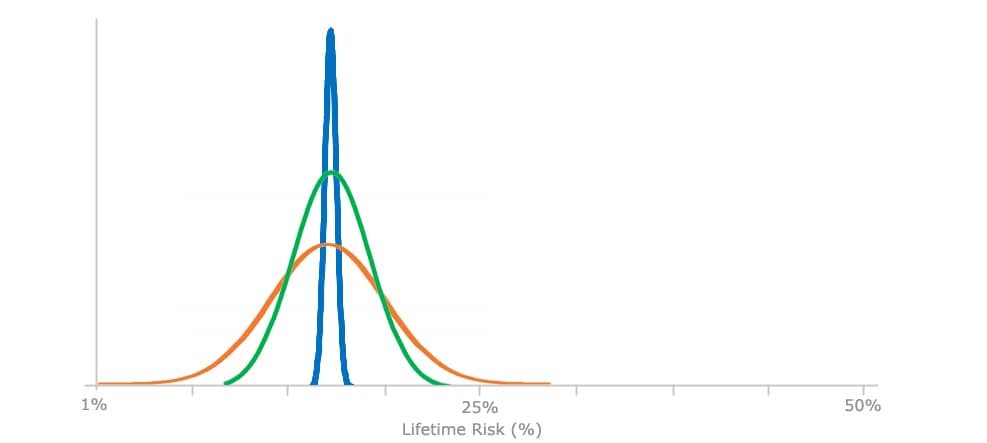Polygenic Risk Scores
What Are Polygenic Risk Scores?
For many chronic conditions, such as heart disease and cancer, your genes affect how likely you are to get a disease. Other factors, such as your environment and behaviors, also play a role. In the population, people commonly have different versions of a gene, and some of these versions are associated with disease risk. An example of precision health, polygenic risk scores combine the different versions of many genes you have that are related to a specific disease.

Polygenic risk scores for a disease for different people in a population are shown above. Each circle represents a person. Those with higher scores (red) are more likely to get the disease and those with lower scores (yellow) are less likely to get the disease. Most people will fall somewhere in the middle (orange). Your polygenic risk score will be different for each specific disease. For example, you might be at low or average genetic risk for one condition, such as heart disease, but at increased genetic risk for another condition, such as colorectal (colon) cancer. As we learn more about genetic differences related to a specific disease, your polygenic risk score for that disease can change.
Why do Polygenic Risk Scores Matter for Health Care and Public Health?
Polygenic risk scores can provide a measure of your disease risk due to your genes. Combining polygenic risk scores with other factors that affect disease risk can give a better idea of how likely you are to get a specific disease than considering either alone. Knowing how likely you are to get a disease can help you take steps to prevent it or find it earlier, when it is easier to treat. Polygenic risk scores can also be combined with other factors to help predict how a disease will progress and how well you will respond to a treatment.

On average, people have a 12.5% (1 in 8) chance of getting disease X (blue), but your personal risk might be higher or lower. Taking into account your genetics, behaviors, and environment can help your doctor get a more accurate estimate of your risk. Currently, doctors include factors such as medication use, smoking status, age, and weight when assessing your risk for disease X (green). This results in a broader range of lifetime risk, and a measure of your likelihood of getting disease X that is more tailored to your individual risk factors. By adding polygenic risk scores (orange), the range widens further and even more accurately shows how likely you are to get disease X.
The Future of Polygenic Risk Scores
Some important issues need to be considered before polygenic risk scores can be routinely used in health care and public health. Studies are looking at how useful polygenic risk scores are in real-life clinical practice. Information on how each gene change affects disease risk comes from population-level genetic studies, such as a genome wide association studies (GWAS). Addressing diversity in development of polygenic risk scores is important because polygenic risk scores developed from studies in one population might not work as well for other populations. Also, how each gene change affects the polygenic score varies from study to study. Once polygenic risk scores are ready to be used routinely in clinical practice, public health efforts will be needed to address issues such as access, insurance coverage, and sharing of results across health systems.